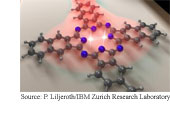|
NEWS
|
Dirty nanotech
It turns out that byproducts of the carbon nanotube
manufacturing process include cancer-causing toxins and
compounds that generate smog and contribute to global
warming. The scientists who measured the carbon nanotube
byproducts plan to help scientists reduce the environmental
impact of carbon nanotube production before the industry
begins its anticipated rapid growth. (Coproducts
of Carbon Nanotube Synthesis: Emerging Contaminants Associated
with the Nanomaterial Revolution [abstract below press
release], 234th national meeting of the American Chemical
Society, Boston, August 22, 2007)
Single-atom bits
The ability to determine the magnetic orientation
of individual atoms is a prerequisite for data storage
devices that are capable of recording a bit in a single
atom. Researchers have now measured the orientation of
individual iron and manganese atoms on copper nitride
surfaces, which brings such devices a step closer. The
storage capacity of such devices would be phenomenal,
allowing, for example, the contents of the YouTube video-sharing
Web site to fit in an iPod-size device. (Large
Magnetic Anisotropy of a Single Atomic Spin Embedded in
a Surface Molecular Network, Science, August
31, 2007)
Molecular turn on
 A stable single-molecule switch that rotates the
position of a pair of hydrogen atoms inside a naphthalocyanine
molecule brings molecular computing closer to reality.
Sending a current through one of the molecules can flip
the switch in an adjacent molecule. This means the molecules
could be linked to form extremely dense logic circuits.
(Current-Induced
Hydrogen Tautomerization and Conductance Switching of
Naphthalocyanine Molecules, Science, August
31, 2007)
A stable single-molecule switch that rotates the
position of a pair of hydrogen atoms inside a naphthalocyanine
molecule brings molecular computing closer to reality.
Sending a current through one of the molecules can flip
the switch in an adjacent molecule. This means the molecules
could be linked to form extremely dense logic circuits.
(Current-Induced
Hydrogen Tautomerization and Conductance Switching of
Naphthalocyanine Molecules, Science, August
31, 2007)
Building a better light switch
A scheme to build a single-photon transistor from
nanowires could make it possible to use one photon to
control and other. Photons ordinarily pass through each
other with little interaction. A photon transistor could
become a building block for quantum computers. (A
Single-Photon Transistor Using Nanoscale Surface Plasmons,
Nature Physics, published online August 26, 2007)
Nano thermometers
Quantum dots -- nanoscale specks of semiconductor
material -- change color when they are heated, which means
they can be used as nanoscale thermometers. Quantum dots
could make it possible to measure the temperature of different
parts of microscopic devices. (Single
Quantum Dots as Local Temperature Markers, Nano
Letters, published online August 30, 2007)
Fracture lines
Pulling apart two plates sandwiching a polymer
film breaks the film into two halves, each of which has
parallel lines that are spaced four times as far as the
thickness of the film. The technique offers a low-cost
route to making micro- and nanoscale gratings, which are
widely used in liquid crystal displays, optical communications
equipment and many other devices. (Self-Formation
of Sub-60-nm Half-Pitch Gratings with Large Areas through
Fracturing, Nature Nanotechnology, published
online September 2, 2007) |
FEATURES
|
View
from the High Ground: ICL's John Pendry
Physics as machine tool, negative refractive
index, metamaterials, shattered wine glasses, higher capacity
DVDs, scientific backwaters, risk perception and practice,
practice, practice.
|
How
It Works: Quantum computing: qubits
Photons, electrons and atoms, oh my! These particles are
the raw materials for qubits, the basic building blocks
of quantum computers. |
|
 |
News RSS feed 
Blog RSS feed 
Bookshelf RSS feed

New: TRN's
Internet Services
TRN's Jobs Center
|
| |
|
| |
|
| |
"Physics
is to the rest of science what machine tools are
to engineering. A corollary is that science places
power in our hands which can be used for good or
ill. Technology has been abused in this way throughout
the ages from gunpowder to atomic bombs."
- John Pendry, Imperial College London |
|
| |
|
| |
Thanks
to Kevin from
GoldBamboo.com
for technical support |
|

